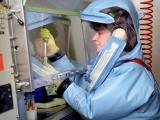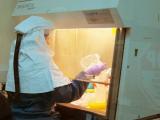Sep 21, 2007 (CIDRAP News) – Foot-and-mouth disease (FMD) was confirmed on a fifth farm in Surrey in southern England this week, but another feared outbreak near Birmingham in the central part of the country was ruled out.
The three most recent FMD confirmations were all on farms near the town of Egham, where the virus reemerged less than a week after the United Kingdom's chief veterinarian announced on Sep 7 that the disease had been eradicated in the area. The disease had been confirmed on two other Surrey farms in early August.
Today the United Kingdom Department for Environment, Food, and Rural Affairs (DEFRA) said FMD is suspected on still another farm in Surrey. After a veterinary inspection on a farm within the existing protection zone, officials decided to slaughter the farm's cattle, the agency said. It was not known how soon test results for the cattle would be available.
The latest confirmed outbreak near Egham was announced Sep 18. Yesterday DEFRA said the strain found there, type 01 BFS67, matched the strain in all the other recent outbreaks. Officials believe the cases have resulted from a leak at an FMD laboratory facility in nearby Pirbright that houses a commercial vaccine producer and a government-funded research institute.
On Sep 19, officials reported suspicious symptoms in cattle on a farm in Solihull, near Birmingham, about 100 miles from Egham. But yesterday the UK Department for Environment, Food and Rural Affairs said lab tests had excluded the disease.
A temporary control zone had been set up around the Solihull farm as a precaution. The farmer alerted authorities when he noticed one of his bulls was frothing at the mouth, which is a possible sign of the disease, the Birmingham Mail reported.
Debby Reynolds, the UK's chief veterinary officer, said in a Sep 19 statement that a postmortem exam of infected cattle on the fifth farm revealed that some of their lesions were more than 10 days old, and she urged farmers to be more vigilant and visually inspect their animals twice a day, rather than once a day as usually recommended.
"This is a disease which can be easily spotted in its early stages. Immediate reporting of any suspicions is critical to the control of this disease," she said in the DEFRA statement.
The continuing outbreaks have sparked discussions about vaccinating animals against the disease. Reynolds has said the government stands ready but has not made the decision to order vaccinations yet.
Colin Fink, a virologist from Warwick University in Coventry, said on a recent BBC radio program that without vaccination, the virus could become more entrenched as autumn sets in, bringing cool weather that may allow the virus to survive, the London Guardian reported yesterday.
"We have a major problem, because without the sunshine to destroy the virus in the field, we're going to have the virus around for a long time," he said on the program.
The government is hesitant to order vaccinations, because European Union rules would then ban cattle exports for 6 months, the Guardian report said, adding that culling for FMD prompts a shorter 3-month ban.
A recent DEFRA report said the FMD leak at Pirbright was likely caused by flooding and faulty wastewater drains. Workers have relined the existing drains and sealed manhole covers, pending construction of a new drainage system.
FMD is an extremely contagious disease that affects cattle, sheep, pigs, and other ruminants, causing sores in the mouth and on the hooves. The debilitating condition does not usually kill adult animals, but it drastically reduces milk production. The disease very rarely affects humans, according to DEFRA.
In the two earlier FMD outbreaks, which were confirmed in early August, veterinary authorities culled nearly 600 animals. A widespread outbreak in Britain in 2001 led to the destruction of 7 million cattle to stop the disease.
See also:
Sep 13 CIDRAP News story "Latest UK foot-and-mouth cases linked to earlier ones"
Sep 7 CIDRAP News story "British blame leaky drain for foot-and-mouth outbreak"

















